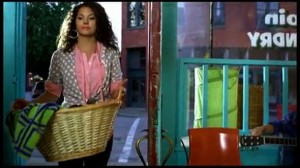 When I took an in-depth look at Justin Bieber’s music video “One Less Lonely Girl,” I concentrated my analysis on the socio-economic and political messages embedded within, but commenter Rosa made this astute observation about the ethnicity of Bieber’s love interest in the video:
When I took an in-depth look at Justin Bieber’s music video “One Less Lonely Girl,” I concentrated my analysis on the socio-economic and political messages embedded within, but commenter Rosa made this astute observation about the ethnicity of Bieber’s love interest in the video:
Also note the carefully cast, ambiguously ethnic love-interests for Mr. JB. I’m sure that helps keep the fan base happy
Rosa’s comment brings up two questions for further analysis:
- Is there anything to this idea of casting Bieber’s music video romantic interests in an ethnically ambiguous manner so as to maximize the video’s appeal to a racially diverse audience?
- What about the rest of the racial/ethnic makeup of the people that appear in Bieber’s music videos? How diverse is the collective cast?
Read on for the exciting conclusions of my latest Bieber-obsession-driven analysis.
Methodology

I know, I keep writing about this kid. I'm kind of obsessed. Just bear with me as I work this out, ok?
Patience, Beliebers. Before we get to the data, I need to explain my research methodology (i.e., how I spent two hours of my life watching Justin Bieber music videos). My first stop was Justin Bieber’s YouTube home page, where there are 9 full-length music videos available for your viewing pleasure. I excluded “Never Say Never” as it heavily features footage from the recent Karate Kid remake, which of course features bazillions of Chinese people. For the remaining 8 videos, I made my best attempt at counting every person who appeared in the video, even in the background, and classify them as either “White,” “Black,” “Asian,” or “Ambiguous/Unknown.” “Ambiguous/Unknown” contains everyone whose skin/hair indicates something other than unambiguously Caucasian or African, as well as those that I couldn’t get a positive ID on, either because their faces were hidden by masks, away from the camera, or otherwise obscured.
I should acknowledge that this racial taxonomy doesn’t really account for “Hispanic” which, although technically isn’t a “race,” is obviously a major “ethnic group” and one of the ways that Americans readily break people down into groups of people for easy stereotyping, discrimination, and “if you marry one of those people, I’ll disown you.” (If you’re really interested, you can read more about the distinction between “race” and “ethnicity” here, but I’m not going down that rat-hole in this piece.) That being said, I’m going to present these breakdowns as-is, as well as with more straightforward White-to-black ratios, and let you all duke it out in the comments.
I should also acknowledge that these stats are the result of my best attempt at counting everyone in the music videos, and that it’s highly likely that I missed a few faces here and there, especially in the large crowd scenes. So if you went and did this on your own (I don’t recommend it–it’s really freaking tedious, and it requires listing to more Justin Bieber music than even I can stand), you’d probably come out with different counts than I did. But I’m pretty sure that your results would be roughly in the same proportions as mine.
OK! Enough with the hedging! Tell me, is Justin Bieber our post-racial savior, or what?
Results – Romantic Interests
This one’s pretty straightforward. Of the eight music videos I included in my analysis, five featured a female romantic interest playing opposite Bieber. Of those five girls, I deemed four (80%) of them to be of “Ambiguous/Unknown” racial/ethnic origin:
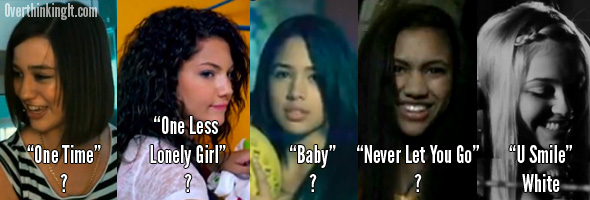
There’s plenty of room for debate regarding the race/ethnicity of the “One Time” girl, but even if you think that she could be white, it’s still pretty remarkable that four out of five of these romantic interests have dark hair and only one is blonde. I say this even while granting the possibility that dark-haired girls were cast in order to provide contrast with Bieber’s blond hair.
My conclusion is that Rosa was onto something with her comment. Bieber’s image-makers have intentionally cast racially/ethnically ambiguous girls to play opposite Bieber in his videos to allow young fans from as many ethnic groups as possible to picture themselves in a similar role…snuggling up to Justin Bieber in a bowling alley or laundromat.
Results – Overall Cast Composition
This one’s note quite as straightforward. If you look at the breakdown across all four groups that I described earlier (White, Black, Asian, Ambiguous/Unknown), You’ll see that White and Black are the largest groups, but Ambiguous/Unknown makes up a not-so-useful 20% of the pie:
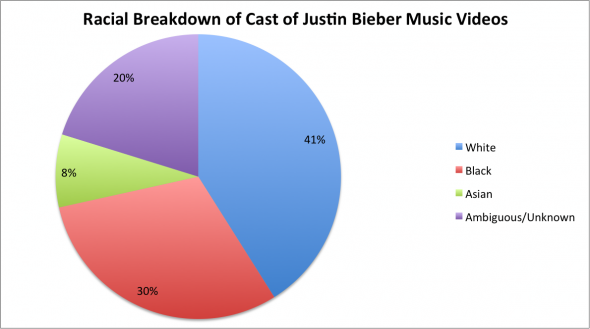
It is worth noting, though, that at 8%, Asians are well over-represented compared to their share of the overall population (about 4%). This is almost entirely due to the large number of Asians in the inexplicably Asian-themed “Somebody to Love” video.
But beyond that, the large Ambiguous/Unknown pie leaves too much uncertainty. So let’s focus on Whites and Blacks, the two groups I was able to count with the highest degree of confidence, and the two groups which are most often at polar opposite ends of demographic trends:
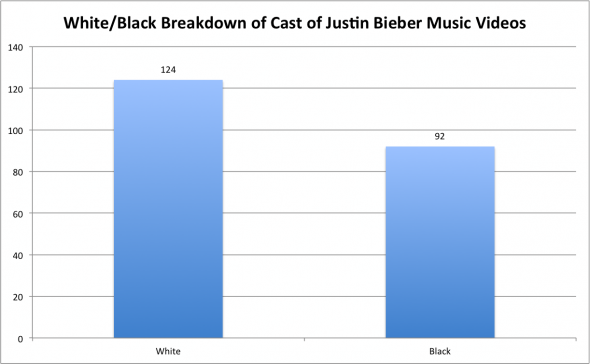
With 124 Whites to 92 Blacks, that works out to a 1.35 White-to-Black ratio. In plain terms, that’s fairly even representation, especially considering that Bieber is a white artists and that in the general US population, (Non-Hispanic) Whites outnumber Blacks by a roughly 5-to-1 ratio:
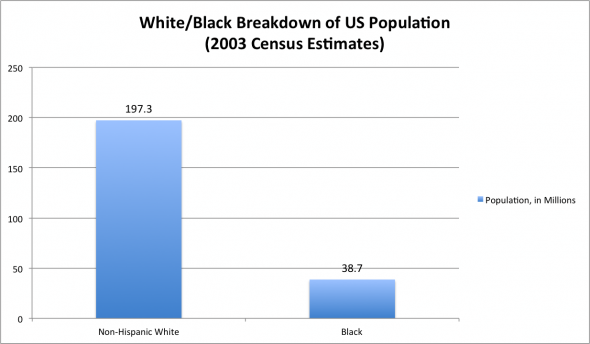
Conclusion – What Does This All Mean?
These results aren’t exactly revelatory or surprising beyond the fun use of statistics to back up things we know intuitively. Of course Justin Bieber’s handlers are trying to maximize his appeal across as many demographics as possible. That’s how they sell more albums, downloads, and concert tickets.
But going back to the question that I somewhat jokingly tossed out at the beginning of this article: Is Justin Bieber our post-racial savior, or what? I put that out there because it seems that some may already see him as such, possibly even Bieber himself. Back in May, when Justin Bieber was nominated for the “Best New Artist” BET Award, The Hollywood Gossip made the astute observation that he was the only non-black artist nominated in the category and declared in its not-so-subtle headline, “Justin Bieber Transcends Race.” As support for this claim, they carried this quote from Stephen Hill, BET’s President of Music Programming and Specials:
Bieber has crossed the color boundaries the same way that hip-hop has crossed the boundaries the other way for a number of years. He’s had rhythm in his music. He makes the type of music our audience likes.
Through a series of Twitter posts, Bieber responded to the news of the BET Award nomination with the following:
Thank u to BET for nominating me for Best New Artist @ the BET Awards this year!! This is an incredible honor and I’m very grateful… read some articles about my bet nomination n (and) i think this goes 2 show that music is color blind… Music is the universal language no matter the country we are born in or the color of our skin. Brings us all together.
Consider what Bieber knows about the space he occupies in the racial discourse at this point: although Bieber is white, he’s operated under the traditionally black R&B genre since his cover versions of R&B songs led to his discovery by Usher, a black R&B singer. At the time of the nomination, he’s already shot four music videos with racially diverse casts and non-white love interests. And Bieber’s BET Awards nomination was only the fourth for a white performer in the history of the awards. It’s easy to see how he perceives himself as some sort of post-racial entertainer.
But consider the irony of using the phrase “color blind” in reference to the “Black Entertainment Television Awards.” Bieber may be correct in saying that that “music is colorblind,” but the music business and the marketplace he sells his music to are anything but. And that’s why it matters if Justin Bieber is nominated for a BET award, if Justin Bieber dances with non-white girls in his videos, and if Justin Bieber has a lot of black people in his videos. We may not live in a post-racial utopia just yet–again, I point to the existence of “Black Entertainment Television”–so until we do, these things matter.
And to the extent that Bieber is able to project a racially/ethnically diverse image, I’d say he’s actually doing a service. It may not be color-blind, but it’s one step towards a day where there won’t be any need for some blogger on the internet to calculate a White-to-Black ratio for Justin Bieber music videos.
And that will be a good day indeed.
[Click through to the next page for a more detailed breakdown of my counts, video-by-video, as well as all of the videos embedded for your listening, viewing, and analyzing pleasure.]
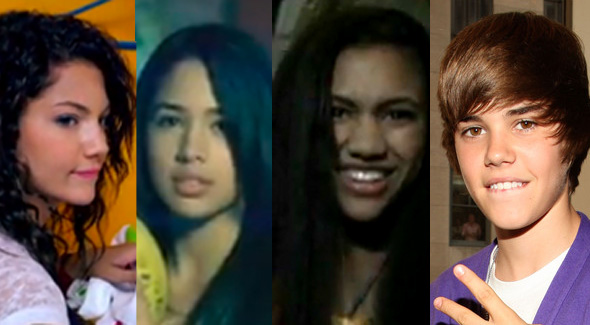
I don’t know anything about Justin Bieber and I’ve never heard this song, but it ought to be “One FEWER Lonely Girl.” That is all.
Naw, he’s saying “one girl that is less lonely than she was previously,” that’s all.
And if it was going to be fewer, shouldn’t it be one fewer lonely girls?
Ha. If he is actually talking about decreasing the overall loneliness of one particular girl without eliminating it entirely – rather than reducing the total number of lonely girls by one – then I have to give him credit for humility, at least.
“Girl, if you, uh, let me inside of your world…I’m gonna be honest here, you’re still going to be lonely, but perhaps slightly less so!”
This ‘Lonely girl’ is interested in Justing Bieber, surely she deserves to be lonely therefore.
lee:
I’d have coded the “Never Let You Go” girl as Black.
Interesting. If I had to choose, I’d go with South Asian (Indian or Pakistani).
lee:
The nose is too perfect.
Granted the hair supports your contention, but that can be straigtened pretty easily.
On your semi-serious question, I think you’re right. I have a lot of contact with older teens/young adults on my job and it BLOWS my FREAKING mind how easily they live in a racially/ethnically/cultural diverse world. Barely a generation ago people were being murdered in the USA for cross-ethnic/racial romance. Nowadays kids literally don’t even notice.
I remember seeing her on Everybody Hates Chris.
Intersting that Justin has taken this a step further and is now dating someone from that Ambiguous/Unknown pie – Selena Gomez. So, have his tastes in women been shaped by his handlers choices in his leading ladies, or have his choices in his leading ladies been shaped by his tastes? What came first, the chicken or the egg?
As a Canadian, I feel obligated to note that Bieber is a fellow Canuck, and that issues of race and ethnicity are generally not as fraught as they are in the US. (Although I doubt that Bieber himself has a lot of say over the casting, or even content, of his videos.)
“Beliebers.” I didn’t realize that was an actual word until I Googled it. It’s fitting, though.
I’m sure you could have hit the ‘Mute’ button on the Bieber, and listened to some Creedence instead. Might have made sitting through those videos easier.
I’m glad to have been inspirational, though sorry that it mean you had to repeatedly watch Bieber videos. I was going to suggest a contrast with Taylor Swift’s videos, but that’s too easy/boring. I do believe she’s pretty exclusively paired with white dudes.
In other Bieber news, Time just pointed out that it’s acceptable for Beiber to be sexualized in Vanity Fair because he’s a dude, whereas Miley got all uproared over. But that may be more a topic for Shna. I like how in the behind-the-scenes video, you can see that they cast a gaggle of multiracial girls that fits your findings.
“One Less Lonely Girl” and “Never Let You Go” are half black/half white. And “Baby” is Jasmine V and Latina.
You know what, I really hate this argument of casting ethnically ambiguous women in order to maximize the video’s appeal to a racially diverse audience. Most Hip Hop/RnB videos or any show with black people tend cast ambiguously brown women to play the love interest of the black rapper/singer.
However, according to TvTropes, she (doesn’t apply to men) can’t be TOO brown. While white women may be limited in Justin Beiber’s music videos, black women are being replaced in all mediums by these “ambiguously brown” women.
I always find it very interesting how Americans tend to use the blanket term ‘Asian’. I’d even understand perhaps lumping all East and South-East Asians together, or all Middle-Easterners together, or whatever for the sake of convenience, but surely the differences between, for instance, Chinese, Indians, and Arabs are so huge to make calling them all just ‘Asian’ very strange. The difference between a Chinese person and an Indian is surely every bit as large as that between a European and an African, and certainly much greater than between Europeans and ‘Hispanics’.
I do understand that you don’t have very many Asians over there, but even so I find it a bizarre categorisation o__O
I’m not sure that’s entirely accurate. I would say that Americans tend to lump East and Southeast Asians together as “Asian,” Middle Easterners as “Arabic”, and Indians as “dots, not feathers.”
In fact, isn’t it a British convention to call Indians Asian?
Far more often than East Asians, yes, because we have stronger links/more immigration/more integration. I make a point of saying East Asian and South Asian because misidentifying someone who is Pakistani as Indian or Korean as Chinese, which should be avoidable anyhow, is pretty bad.
There’s a certain amount of South Asians using the word ‘brown’ but I’ve not heard any white people doing that yet. And probably with good reason.
Justin Bieber baby ooh and one less lonely girl,is ok for teens,but as I turn 23 I find that I started to gravitate to more songs by grown up singers like Arden bright alter ego or Ed Sheeran shape of you. Those kinds of songs start to do it for me.